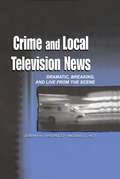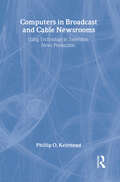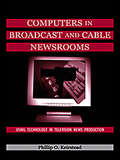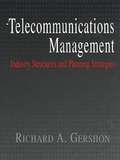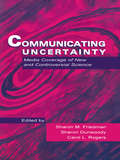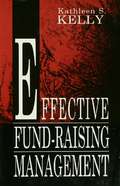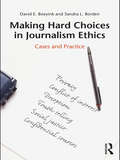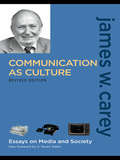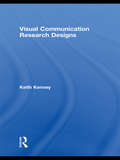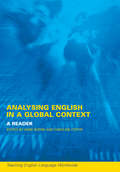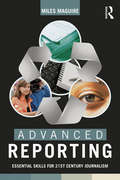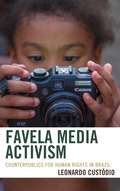- Table View
- List View
Crime and Local Television News: Dramatic, Breaking, and Live From the Scene
by Jeremy H. Lipschultz Michael L. HiltThis volume offers an analysis of crime coverage on local television, exploring the nature of local television news and the ongoing appeal of crime stories. Drawing on the perspectives of media studies, psychology, sociology, and criminology, authors Jeremy H. Lipschultz and Michael L. Hilt focus on live local television coverage of crime and examine its irresistibility to viewers and its impact on society's perceptions of itself. They place local television news in its theoretical and historical contexts, and consider it through the lens of legal, ethical, racial, aging, and technological concerns. In its comprehensive examination of how local television newsrooms around the country address coverage of crime, this compelling work discusses such controversial issues as the use of crime coverage to build ratings, and considers new models for reform of local TV newscasts. The volume includes national survey data from news managers and content analyses from late night newscasts in a range of markets, and integrates the theory and practice of local television news into the discussion. Lipschultz and Hilt also project the future of local television news and predict the impact of social and technological changes on news. As a provocative look at the factors and forces shaping local news and crime coverage, Crime and Local Television News makes an important contribution to the discussions taking place in broadcast journalism, mass communication, media and society, and theory and research courses. It will also interest all who consider the impact of local news content and coverage.
Computers in Broadcast and Cable Newsrooms: Using Technology in Television News Production
by Phillip O. KeirsteadComputers in Broadcast and Cable Newsrooms: Using Technology in Television News Production takes readers through the use of computers and software in the broadcast/cable newsroom environment. Author Phillip O. Keirstead began writing about television news technology decades ago in an effort to help television news managers cope with technological change. In this text, he demonstrates the myriad ways in which today's journalism is tied to technology, and he shows how television news journalists rely on varied and complex technologies to produce timely, interesting, and informative broadcasts. Using a hands-on, practical approach to cover the role computers play in various parts of the newsroom, the volume will be of great practical value to undergraduate and graduate students in advanced broadcast/news television courses.
Computers in Broadcast and Cable Newsrooms: Using Technology in Television News Production
by Phillip O. KeirsteadComputers in Broadcast and Cable Newsrooms: Using Technology in Television News Production takes readers through the use of computers and software in the broadcast/cable newsroom environment. Author Phillip O. Keirstead began writing about television news technology decades ago in an effort to help television news managers cope with technological change. In this text, he demonstrates the myriad ways in which today's journalism is tied to technology, and he shows how television news journalists rely on varied and complex technologies to produce timely, interesting, and informative broadcasts. Using a hands-on, practical approach to cover the role computers play in various parts of the newsroom, the volume will be of great practical value to undergraduate and graduate students in advanced broadcast/news television courses.
Human Communication Theory and Research: Concepts, Contexts, and Challenges
by Robert L. Heath Jennings BryantHuman Communication Theory and Research introduces students to the growing body of theory and research in communication, demonstrating the integration between the communication efforts of interpersonal, organizational, and mediated settings. This second edition builds from the foundation of the original volume to demonstrate the rich array of theories, theoretical connections, and research findings that drive the communication discipline. Robert L. Heath and Jennings Bryant have added a chapter on new communication technologies and have increased depth throughout the volume, particularly in the areas of social meaning, critical theory and cultural studies, and organizational communication. The chapters herein are arranged to provide insight into the breadth of studies unique to communication, acknowledging along the way the contributions of researchers from psychology, political science, and sociology. Heath and Bryant chart developments and linkages within and between ways of looking at communication. The volume establishes an orientation for the social scientific study of communication, discussing principles of research, and outlining the requirements for the development and evaluation of theories. Appropriate for use in communication theory courses at the advanced undergraduate and graduate level, this text offers students insights to understanding the issues and possible answers to the question of what communication is in all forms and contexts.
Human Communication Theory and Research: Concepts, Contexts, and Challenges
by Robert L. Heath Jennings BryantHuman Communication Theory and Research introduces students to the growing body of theory and research in communication, demonstrating the integration between the communication efforts of interpersonal, organizational, and mediated settings. This second edition builds from the foundation of the original volume to demonstrate the rich array of theories, theoretical connections, and research findings that drive the communication discipline. Robert L. Heath and Jennings Bryant have added a chapter on new communication technologies and have increased depth throughout the volume, particularly in the areas of social meaning, critical theory and cultural studies, and organizational communication. The chapters herein are arranged to provide insight into the breadth of studies unique to communication, acknowledging along the way the contributions of researchers from psychology, political science, and sociology. Heath and Bryant chart developments and linkages within and between ways of looking at communication. The volume establishes an orientation for the social scientific study of communication, discussing principles of research, and outlining the requirements for the development and evaluation of theories. Appropriate for use in communication theory courses at the advanced undergraduate and graduate level, this text offers students insights to understanding the issues and possible answers to the question of what communication is in all forms and contexts.
Telecommunications Management
by Richard GershonWith today's communications industry experiencing major changes on an almost daily basis, media managers must have a clear understanding of the different delivery platforms, as well as a grasp of critical management, planning, and economic factors in order to stay current and move their organizations forward. Telecommunications Management helps current and future media professionals understand the relationship and convergence patterns between the broadcast, cable television, telephony, and Internet communication industries. Author Richard A. Gershon examines telecommunications industry structures and the management practices and business strategies affecting the delivery of information and entertainment services to consumers. He brings in specialists to present the finer points of management and planning responsibilities. Case studies from the International Radio and Television Society (IRTS) competition supplement the main text and offer an invaluable perspective on management issues. Developed for students in telecommunications management, electronic media management, and telecommunication economics, this volume also serves as a practical reference for the professional manager.
Telecommunications Management
by Richard GershonWith today's communications industry experiencing major changes on an almost daily basis, media managers must have a clear understanding of the different delivery platforms, as well as a grasp of critical management, planning, and economic factors in order to stay current and move their organizations forward. Telecommunications Management helps current and future media professionals understand the relationship and convergence patterns between the broadcast, cable television, telephony, and Internet communication industries. Author Richard A. Gershon examines telecommunications industry structures and the management practices and business strategies affecting the delivery of information and entertainment services to consumers. He brings in specialists to present the finer points of management and planning responsibilities. Case studies from the International Radio and Television Society (IRTS) competition supplement the main text and offer an invaluable perspective on management issues. Developed for students in telecommunications management, electronic media management, and telecommunication economics, this volume also serves as a practical reference for the professional manager.
Communicating Uncertainty: Media Coverage of New and Controversial Science
by Sharon M. Friedman Sharon Dunwoody Carol L. RogersExploring the interactions that swirl around scientific uncertainty and its coverage by the mass media, this volume breaks new ground by looking at these issues from three different perspectives: that of communication scholars who have studied uncertainty in a number of ways; that of science journalists who have covered these issues; and that of scientists who have been actively involved in researching uncertain science and talking to reporters about it. In particular, Communicating Uncertainty examines how well the mass media convey to the public the complexities, ambiguities, and controversies that are part of scientific uncertainty. In addition to its new approach to scientific uncertainty and mass media interactions, this book distinguishes itself in the quality of work it assembles by some of the best known science communication scholars in the world. This volume continues the exploration of interactions between scientists and journalists that the three coeditors first documented in their highly successful volume, Scientists and Journalists: Reporting Science as News, which was used for many years as a text in science journalism courses around the world.
Communicating Uncertainty: Media Coverage of New and Controversial Science
by Sharon M. Friedman Sharon Dunwoody Carol L. RogersExploring the interactions that swirl around scientific uncertainty and its coverage by the mass media, this volume breaks new ground by looking at these issues from three different perspectives: that of communication scholars who have studied uncertainty in a number of ways; that of science journalists who have covered these issues; and that of scientists who have been actively involved in researching uncertain science and talking to reporters about it. In particular, Communicating Uncertainty examines how well the mass media convey to the public the complexities, ambiguities, and controversies that are part of scientific uncertainty. In addition to its new approach to scientific uncertainty and mass media interactions, this book distinguishes itself in the quality of work it assembles by some of the best known science communication scholars in the world. This volume continues the exploration of interactions between scientists and journalists that the three coeditors first documented in their highly successful volume, Scientists and Journalists: Reporting Science as News, which was used for many years as a text in science journalism courses around the world.
Effective Fund-Raising Management
by Kathleen S. KellyIn a ground-breaking departure from existing works, almost all of which are how-to manuals based on anecdotal evidence, this is the first academic textbook on fund raising. By integrating practical knowledge with social science theory and research, it presents a comprehensive approach to the function, from its legal and ethical principles to the managerial process by which gifts are raised. Territory previously uncharted in the literature is explored, such as the historical and organizational contexts of contemporary practice. Explanations of programs, techniques, and publics introduce a new system for understanding fund raising's major concepts. Unlike efforts in established fields, most of the material represents original scholarship undertaken to produce a first-time text. The book's main purpose is to teach students about fund raising--a high-demand, high-paying occupation that will continue to expand into the 21st century as the need for trained practitioners exceeds the supply. During the last decade, fund-raising education moved into the formal classroom and away from an apprenticeship tradition of senior practitioners mentoring newcomers. Yet until now, there has not been a textbook to support this evolving professionalism. Faculty have been reluctant to define fund raising as an academic subject in the absence of a theory-based teaching resource, and courses usually have been assigned to part-time instructors hired from the practice. This textbook addresses the void. It is designed for graduate and upper-level undergraduate courses dealing with fund raising as a primary or secondary subject. Among its features, each chapter points out research gaps and opportunities--such as problems and theories for master's theses and doctoral dissertations--and ends with a list of suggested readings. The text is appropriate for the diverse academic areas in which fund raising, nonprofit management, and philanthropy are taught, including public administration, management, arts and humanities, education, social work, economics, and sociology. Because of its public relations orientation, it is particularly suited for courses offered in that discipline. Additional audiences are practitioners enrolled in professional development programs; CEOs, trustees, and others interested in self-study; and scholars who need serious literature on the subject.PROFESSIONAL PROMO PIECE COPY..............Recently, the field of fundraising seems to have taken a giant step backward. Rather than conducting principled efforts to support common political, educational, financial, or social causes, the entire process is making headlines as a venue offering opportunities for influence peddling, corruption and self-promotion. The need for a guide to ethical fund-raising management is greater than ever. Effective Fund-Raising Management addresses this need.The most successful fundraisers understand why certain practices are more effective than others. What works in one situation may not work in another similar--but slightly different--situation. That is why theoretical understanding is vital to fundraising professionals. To be an expert practitioner, one must have have enough theoretical understanding to adapt one's practice to a variety of situations. That is the purpose of Effective Fund-Raising Management--to provide the underlying theoretical and conceptual understandings that enable an effective practitioner to become an expert practitioner.Indispensable to fund-raising professionals, this invaluable resource: * reviews the entire scope of the fund-raising profession-- from its historical antecedents to the current legal, ethical, organizational, and theoretical principles underlying its practice today;* provides concise definitions and explanations of the fund-raising process and its position within the field of public relations;* links effective fund-raising practices to ethical considerations; and * examines four of the major methods of fund raising-- annual giving, major gifts, planned giving, and capital campaigns.
Effective Fund-Raising Management
by Kathleen S. KellyIn a ground-breaking departure from existing works, almost all of which are how-to manuals based on anecdotal evidence, this is the first academic textbook on fund raising. By integrating practical knowledge with social science theory and research, it presents a comprehensive approach to the function, from its legal and ethical principles to the managerial process by which gifts are raised. Territory previously uncharted in the literature is explored, such as the historical and organizational contexts of contemporary practice. Explanations of programs, techniques, and publics introduce a new system for understanding fund raising's major concepts. Unlike efforts in established fields, most of the material represents original scholarship undertaken to produce a first-time text. The book's main purpose is to teach students about fund raising--a high-demand, high-paying occupation that will continue to expand into the 21st century as the need for trained practitioners exceeds the supply. During the last decade, fund-raising education moved into the formal classroom and away from an apprenticeship tradition of senior practitioners mentoring newcomers. Yet until now, there has not been a textbook to support this evolving professionalism. Faculty have been reluctant to define fund raising as an academic subject in the absence of a theory-based teaching resource, and courses usually have been assigned to part-time instructors hired from the practice. This textbook addresses the void. It is designed for graduate and upper-level undergraduate courses dealing with fund raising as a primary or secondary subject. Among its features, each chapter points out research gaps and opportunities--such as problems and theories for master's theses and doctoral dissertations--and ends with a list of suggested readings. The text is appropriate for the diverse academic areas in which fund raising, nonprofit management, and philanthropy are taught, including public administration, management, arts and humanities, education, social work, economics, and sociology. Because of its public relations orientation, it is particularly suited for courses offered in that discipline. Additional audiences are practitioners enrolled in professional development programs; CEOs, trustees, and others interested in self-study; and scholars who need serious literature on the subject.PROFESSIONAL PROMO PIECE COPY..............Recently, the field of fundraising seems to have taken a giant step backward. Rather than conducting principled efforts to support common political, educational, financial, or social causes, the entire process is making headlines as a venue offering opportunities for influence peddling, corruption and self-promotion. The need for a guide to ethical fund-raising management is greater than ever. Effective Fund-Raising Management addresses this need.The most successful fundraisers understand why certain practices are more effective than others. What works in one situation may not work in another similar--but slightly different--situation. That is why theoretical understanding is vital to fundraising professionals. To be an expert practitioner, one must have have enough theoretical understanding to adapt one's practice to a variety of situations. That is the purpose of Effective Fund-Raising Management--to provide the underlying theoretical and conceptual understandings that enable an effective practitioner to become an expert practitioner.Indispensable to fund-raising professionals, this invaluable resource: * reviews the entire scope of the fund-raising profession-- from its historical antecedents to the current legal, ethical, organizational, and theoretical principles underlying its practice today;* provides concise definitions and explanations of the fund-raising process and its position within the field of public relations;* links effective fund-raising practices to ethical considerations; and * examines four of the major methods of fund raising-- annual giving, major gifts, planned giving, and capital campaigns.
The Two W's of Journalism: The Why and What of Public Affairs Reporting
by Davis Buzz" Merritt Maxwell E. McCombsIn this timely volume, the authors explore public affairs journalism, a practice that lies at the core of the journalism profession. They go beyond the journalistic instruction for reporting and presenting news to reflect on why journalism works the way it does. Asking current and future journalists the critical questions, "Why do we do it?" and "What are the ways of fulfilling the goals of journalism?" their discussion stimulates the examination of contemporary practice, probing the foundations of public affairs journalism. With its detailed examination of factors influencing current journalistic practice, The Two W's of Journalism complements and expands on the skills and techniques presented in reporting, editing, and news writing textbooks. The perspectives presented here facilitate understanding of the larger role journalism has in society. As such, the volume is an excellent supplemental text for reporting and writing courses, and for introductory courses on journalism. It will also offer valuable insights to practicing journalists.
The Two W's of Journalism: The Why and What of Public Affairs Reporting
by Davis Buzz" Merritt Maxwell E. McCombsIn this timely volume, the authors explore public affairs journalism, a practice that lies at the core of the journalism profession. They go beyond the journalistic instruction for reporting and presenting news to reflect on why journalism works the way it does. Asking current and future journalists the critical questions, "Why do we do it?" and "What are the ways of fulfilling the goals of journalism?" their discussion stimulates the examination of contemporary practice, probing the foundations of public affairs journalism. With its detailed examination of factors influencing current journalistic practice, The Two W's of Journalism complements and expands on the skills and techniques presented in reporting, editing, and news writing textbooks. The perspectives presented here facilitate understanding of the larger role journalism has in society. As such, the volume is an excellent supplemental text for reporting and writing courses, and for introductory courses on journalism. It will also offer valuable insights to practicing journalists.
Making Hard Choices in Journalism Ethics: Cases and Practice
by David E. Boeyink Sandra L. BordenThis book teaches students how to make the difficult ethical decisions that journalists routinely face. By taking a case-based approach, the authors argue that the best way to make an ethical decision is to look closely at a particular situation, rather than looking first to an abstract set of ethical theories or principles. This book goes beyond the traditional approaches of many other journalism textbooks by using cases as the starting point for building ethical practices. Casuistry, the technical name of such a method, develops provisional guidelines from the bottom up by reasoning analogically from an "easy" ethical case (the "paradigm") to "harder" ethical cases. Thoroughly grounded in actual experience, this method admits more nuanced judgments than most theoretical approaches.
Making Hard Choices in Journalism Ethics: Cases and Practice
by David E. Boeyink Sandra L. BordenThis book teaches students how to make the difficult ethical decisions that journalists routinely face. By taking a case-based approach, the authors argue that the best way to make an ethical decision is to look closely at a particular situation, rather than looking first to an abstract set of ethical theories or principles. This book goes beyond the traditional approaches of many other journalism textbooks by using cases as the starting point for building ethical practices. Casuistry, the technical name of such a method, develops provisional guidelines from the bottom up by reasoning analogically from an "easy" ethical case (the "paradigm") to "harder" ethical cases. Thoroughly grounded in actual experience, this method admits more nuanced judgments than most theoretical approaches.
Communication as Culture, Revised Edition: Essays on Media and Society
by James W. CareyIn this classic text, James W. Carey maintains that communication is not merely the transmission of information; reminding the reader of the link between the words "communication" and "community," he broadens his definition to include the drawing-together of a people that is culture. In this context, Carey questions the American tradition of focusing only on mass communication's function as a means of social and political control, and makes a case for examining the content of a communication—the meaning of symbols, not only the motives that originate them or the purposes they serve. He seeks to recast the goal of communication studies, replacing the search for deterministic laws of behavior with a simpler, yet far more challenging mission: "to enlarge the human conversation by comprehending what others are saying." This new edition includes a new critical foreword by G. Stuart Adam that explains Carey's fundamental role in transforming the study of mass communication to include a cultural perspective and connects his classic essays with contemporary media issues and trends. This edition also adds a new, complete bibliography of all of Carey's writings.
The Code Book: The Science Of Secrecy Form Ancient Agypt To Quantum Cryptography (PDF)
by Simon SinghThe Science of Secrecy from Ancient Egypt to Quantum Cryptography From the best-selling author of Fermat's Last Theorem, The Code Book is a history of man's urge to uncover the secrets of codes, from Egyptian puzzles to modern day computer encryptions. As in Fermat's Last Theorem, Simon Singh brings life to an anstonishing story of puzzles, codes, languages and riddles that reveals man's continual pursuit to disguise and uncover, and to work out the secret languages of others. Codes have influenced events throughout history, both in the stories of those who make them and those who break them. The betrayal of Mary Queen of Scots and the cracking of the enigma code that helped the Allies in World War II are major episodes in a continuing history of cryptography. In addition to stories of intrigue and warfare, Simon Singh also investigates other codes, the unravelling of genes and the rediscovery of ancient languages and most tantalisingly, the Beale ciphers, an unbroken code that could hold the key to a USD 20 million treasure.
Visual Communication Research Designs
by Keith KenneyVisual Communication Research Designs provides a step-by-step guide for designing research involving visuals relevant to communications media. This volume explains the process from conceptualization to research questions, instrumentation, analysis, and reliability and validity checks. It also addresses the lack of sufficient methods to answer theoretical questions attending visual communication. This resource has been developed in response to the circumstance in which, in many cases, the methodologies used for verbal and textual communications are inappropriate or ineffective when applied or adapted for the study of visual communications. Additionally, research articles from ethnography, action research, rhetoric, semiotics, psychology, cultural studies, and critical theory often do not use examples appropriate to visual communication readers. To address these issues, this book explains in clear and straightforward language key research designs, including new methodologies, that are appropriate for scholars and students conducting visual communication research. Organized into three parts -- production, analysis, and effects of visuals – this research text provides guidance in using, interpreting and measuring the effects of visual images. It addresses such topics as: producing photographs and video that can be used as research data; interpreting images that already exist; measuring the effects of visuals and to understand their use by different groups. Ethical issues are included, as well as a discussion of the advantages and limitations of each method. "War stories" are provided by experienced researchers, who discuss a particular research project and explain pitfalls to avoid, as well as what to do when problems occur. The primary audiences are scholars, researchers, and students conducting research on motion pictures, video, television, photographs, illustrations, graphics, typography, political cartoons, comic books, animation, and other media with a visual component. Individuals will use this text whenever they need to conduct research that involves visuals in the media. The book will be a required text for advanced courses in visual culture, seminars on visual communication research, and other research methods courses integrating a visual component.
English As A Global Language (PDF)
by David CrystalDavid Crystal, world authority on the English language, presents a lively and factual account of the rise of English as a global language and explores the whys and wherefores of the history, current status and future potential of English as the international language of communication. English has been lauded as the most 'successful' language ever, with 1,500 million speakers worldwide; but Crystal avoids taking sides and tells the story in a measured but engaging way, backed by facts and figures. This new edition of his classic book includes new material (on the vocabulary, grammar and pronunciation of New Englishes), footnotes, new tables, and a full bibliography. There are updates throughout. This is a book for anyone of any nationality concerned with English: teachers, students, language professionals, politicians, general readers and anyone with a love of the language.
Information and Communication Technologies in Action: Linking Theories and Narratives of Practice
by Larry D. Browning Alf Steinar Saetre Keri Stephens Jan-Oddvar SornesThis book combines 20 stories from a variety of organizations with a selection of nine theories, both mainstream and emerging. The stories introduce readers to individuals talking about how they communicate today via information and communication technologies (ICTs) in business or organizational contexts. The theories, presented in accessible language, illuminate the implicit patterns in these stories. This book demonstrates how and why these technologies are used under myriad circumstances.
Information and Communication Technologies in Action: Linking Theories and Narratives of Practice
by Larry D. Browning Alf Steinar Saetre Keri Stephens Jan-Oddvar SornesThis book combines 20 stories from a variety of organizations with a selection of nine theories, both mainstream and emerging. The stories introduce readers to individuals talking about how they communicate today via information and communication technologies (ICTs) in business or organizational contexts. The theories, presented in accessible language, illuminate the implicit patterns in these stories. This book demonstrates how and why these technologies are used under myriad circumstances.
Analysing English In A Global Context (PDF)
by Anne Burns Caroline CoffinDevised in collaboration with the Open University and Macquarie University, Australia, this book is specifically designed for the postgraduate student market, as well as for teachers of English as a second or foreign language throughout the world. It includes specially commissioned pieces as well as classic texts and provides a global perspective on the changing uses and forms of English and its impact on language teaching contexts.
Advanced Reporting: Essential Skills for 21st Century Journalism
by Miles MaguireNews gathering is a large, complicated and often messy task that has traditionally been viewed by journalists as irretrievably idiosyncratic, best learned through trial and error. Advanced Reporting takes the opposite approach, focusing on reporting as a process of triangulation based on three essential activities: analyzing documents, making observations and conducting interviews. In this readable book, veteran journalism professor Miles Maguire shows how the best reporters use these three tools in a way that allows them to cross-check and authenticate facts, to reduce or eliminate unsupportable allegations and to take readers and viewers to a deeper level of insight and understanding. This book will help to prepare students for a profession marked by increasing complexity and competition. To succeed in this environment, journalists must learn to make the most of digital media to intensify the impact of their work. At the same time, reporters must contend with a host of sophisticated public relations techniques while engaging with news audiences that no longer just consume journalism, but also collaborate in its creation. Discussion questions and exercises help students put theory into practice.
Advanced Reporting: Essential Skills for 21st Century Journalism
by Miles MaguireNews gathering is a large, complicated and often messy task that has traditionally been viewed by journalists as irretrievably idiosyncratic, best learned through trial and error. Advanced Reporting takes the opposite approach, focusing on reporting as a process of triangulation based on three essential activities: analyzing documents, making observations and conducting interviews. In this readable book, veteran journalism professor Miles Maguire shows how the best reporters use these three tools in a way that allows them to cross-check and authenticate facts, to reduce or eliminate unsupportable allegations and to take readers and viewers to a deeper level of insight and understanding. This book will help to prepare students for a profession marked by increasing complexity and competition. To succeed in this environment, journalists must learn to make the most of digital media to intensify the impact of their work. At the same time, reporters must contend with a host of sophisticated public relations techniques while engaging with news audiences that no longer just consume journalism, but also collaborate in its creation. Discussion questions and exercises help students put theory into practice.
Favela Media Activism: Counterpublics for Human Rights in Brazil (PDF)
by Leonardo CustódioWhat explains the engagement of low-income young people in media initiatives for political mobilization and social change in everyday life? Favela Media Activism: Counterpublics for Human Rights in Brazil responds to this question using an in-depth ethnographic and interdisciplinary study about the trajectories in media activism among young residents of low-income and violence-ridden favelas in socially unequal Rio de Janeiro. Leonardo Custodio provides multifaceted analyses of how favela youth engage in individual and collective media activist initiatives despite social class constraints and neoliberal imperatives in their everyday life. This book details processes experienced by young favela residents while becoming individuals who act to challenge and change patterns of discrimination, governmental neglect and drug-related violence. It is an important resource for scholars interested in the nuances of political engagement among marginalized youth in today's world of hyper-connectivity, information abundance, and the persistence of racial and social inequalities.
